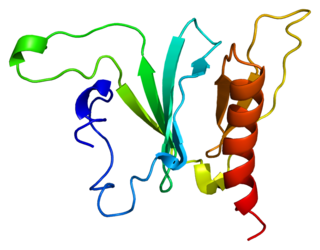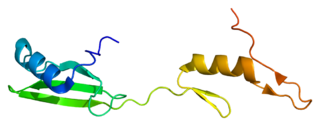
Son of sevenless homolog 1 is a protein that in humans is encoded by the SOS1 gene.

Fibroblast growth factor receptor 1 (FGFR1), also known as basic fibroblast growth factor receptor 1, fms-related tyrosine kinase-2 / Pfeiffer syndrome, and CD331, is a receptor tyrosine kinase whose ligands are specific members of the fibroblast growth factor family. FGFR1 has been shown to be associated with Pfeiffer syndrome, and clonal eosinophilias.

Platelet-derived growth factor receptor beta is a protein that in humans is encoded by the PDGFRB gene. Mutations in PDGFRB are mainly associated with the clonal eosinophilia class of malignancies.

Cytoplasmic protein NCK1 is a protein that in humans is encoded by the NCK1 gene.

Immunoglobulin-binding protein 1 is a protein that in humans is encoded by the IGBP1 gene.

SOGA2, also known as Suppressor of glucose autophagy associated 2 or CCDC165, is a protein that in humans is encoded by the SOGA2 gene. SOGA2 has two human paralogs, SOGA1 and SOGA3. In humans, the gene coding sequence is 151,349 base pairs long, with an mRNA of 6092 base pairs, and a protein sequence of 1586 amino acids. The SOGA2 gene is conserved in gorilla, baboon, galago, rat, mouse, cat, and more. There is distant conservation seen in organisms such as zebra finches and anoles. SOGA2 is ubiquitously expressed in humans, with especially high expression in brain, colon, pituitary gland, small intestine, spinal cord, testis and fetal brain.

Chromosome 20 open reading frame 111, or C20orf111, is the hypothetical protein that in humans is encoded by the C20orf111 gene. C20orf111 is also known as Perit1, HSPC207, and dJ1183I21.1. It was originally located using genomic sequencing of chromosome 20. The National Center for Biotechnology Information, or NCBI, shows that it is located at q13.11 on chromosome 20, however the genome browser at the University of California-Santa Cruz (UCSC) website shows that it is at location q13.12, and within a million base pairs of the adenosine deaminase locus. It was also found to have an increase in expression in cells undergoing hydrogen peroxide(H
2O
2)-induced apoptosis. After analyzing the amino acid content of C20orf111, it was found to be rich in serine residues.

Transmembrane protein 131 (TMEM131) is a protein that is encoded by the TMEM131 gene in humans. The TMEM131 protein contains three domains of unknown function 3651 (DUF3651) and two transmembrane domains. This protein has been implicated as having a role in T cell function and development. TMEM131 also resides in a locus (2q11.1) that is associated with Nievergelt's Syndrome when deleted.

WW and C2 domain containing 2 (WWC2) is a protein that in humans is encoded by the WWC2 gene (4q35.1). Though function of WWC2 remains unknown, it has been predicted that WWC2 may play a role in cancer.

C8orf48 is a protein that in humans is encoded by the C8orf48 gene. C8orf48 is a nuclear protein specifically predicted to be located in the nuclear lamina. C8orf48 has been found to interact with proteins that are involved in the regulation of various cellular responses like gene expression, protein secretion, cell proliferation, and inflammatory responses. This protein has been linked to breast cancer and papillary thyroid carcinoma.

Glutamate rich protein 5 is a protein in humans encoded by the ERICH5 gene, also known as chromosome 8 open reading frame 47 (C8orf47).

CRACD-like protein. previously known as KIAA1211L is a protein that in humans is encoded by the CRACDL gene. It is highly expressed in the cerebral cortex of the brain. Furthermore, it is localized to the microtubules and the centrosomes and is subcellularly located in the nucleus. Finally, CRACDL is associated with certain mental disorders and various cancers.

Chromosome 3 Open Reading Frame 62 (C3orf62), is a protein that in humans is encoded by the C3orf62 gene. C3orf62 is a glycine depleted protein relative to the amount of glycine in proteins in the rest of the genome. C3orf62 has a KKXX-like motif and is predicted to be localized in the nucleus. Expression of C3orf62 remains highest in whole blood.

Protein FAM208B is a protein that in humans is encoded by the FAM208B gene. The gene is also known as "chromosome 10 open reading frame 18" (c10orf18). FAM208B is expressed throughout the body however its function has not been established. FAM208b has been observed to be differentially regulated in various cancers and throughout development. While the exact role of the protein is yet to be established, the significant presence of the protein within humans and throughout the phylogenetic tree depicts a central importance of the gene in normal function.

C22orf23 is a protein which in humans is encoded by the C22orf23 gene. Its predicted secondary structure consists of alpha helices and disordered/coil regions. It is expressed in many tissues and highest in the testes and it is conserved across many orthologs.

TMEM128, also known as Transmembrane Protein 128, is a protein that in humans is encoded by the TMEM128 gene. TMEM128 has three variants, varying in 5' UTR's and start codon location. TMEM128 contains four transmembrane domains and is localized in the Endoplasmic Reticulum membrane. TMEM128 contains a variety of regulation at the gene, transcript, and protein level. While the function of TMEM128 is poorly understood, it interacts with several proteins associated with the cell cycle, signal transduction, and memory.

WD Repeat and Coiled-coiled containing protein (WDCP) is a protein which in humans is encoded by the WDCP gene. The function of the protein is not completely understood, but WDCP has been identified in a fusion protein with anaplastic lymphoma kinase found in colorectal cancer. WDCP has also been identified in the MRN complex, which processes double-stranded breaks in DNA.

SH3 Domain Binding Kinase Family Member 3 is an enzyme that in humans is encoded by the SBK3 gene. SBK3 is a member of the serine/threonine protein kinase family. The SBK3 protein is known to exhibit transferase activity, especially phosphotransferase activity, and tyrosine kinase activity. It is well-conserved throughout mammalian organisms and has two paralogs: SBK1 and SBK2.

C6orf136 is a protein in humans encoded by the C6orf136 gene. The gene is conserved in mammals, mollusks, as well some porifera. While the function of the gene is currently unknown, C6orf136 has been shown to be hypermethylated in response to FOXM1 expression in Head Neck Squamous Cell Carcinoma (HNSCC) tissue cells. Additionally, elevated expression of C6orf136 has been associated with improved survival rates in patients with bladder cancer. C6orf136 has three known isoforms.

Family with sequence 98, member C or FAM98C is a gene that encodes for FAM98C has two aliases FLJ44669 and hypothetical protein LOC147965. FAM98C has two paralogs in humans FAM98A and FAM98B. FAM98C can be characterized for being a Leucine-rich protein. The function of FAM98C is still not defined. FAM98C has orthologs in mammals, reptiles, and amphibians and has a distant orhtologs in Rhinatrema bivittatum and Nanorana parkeri.




















